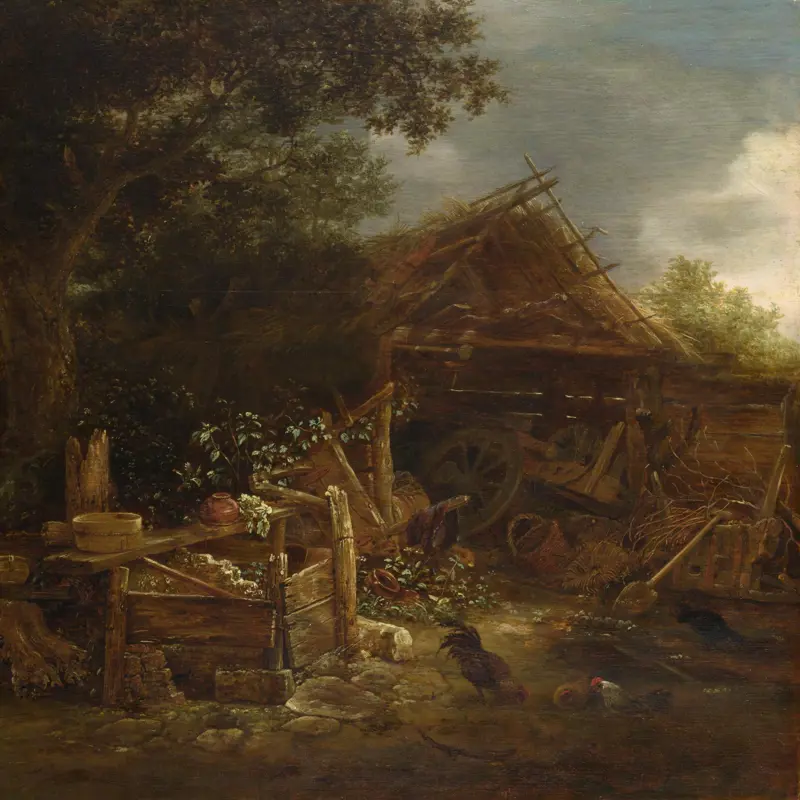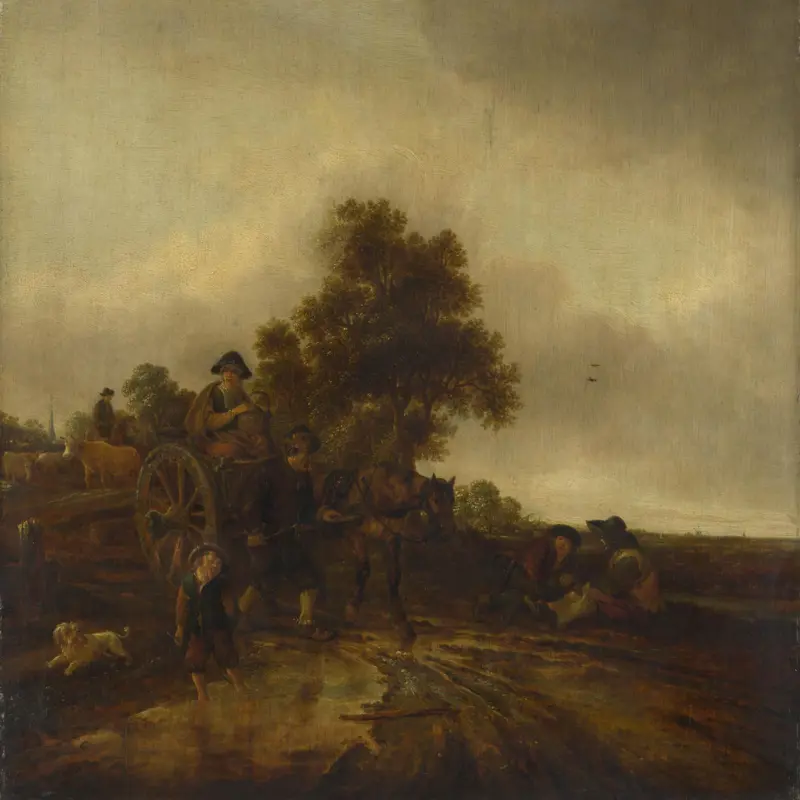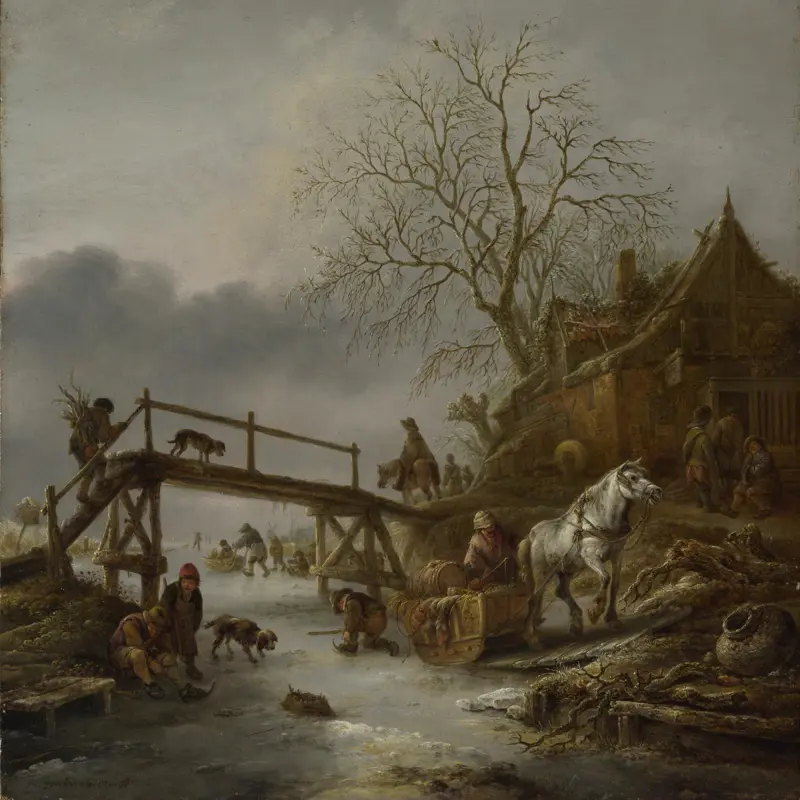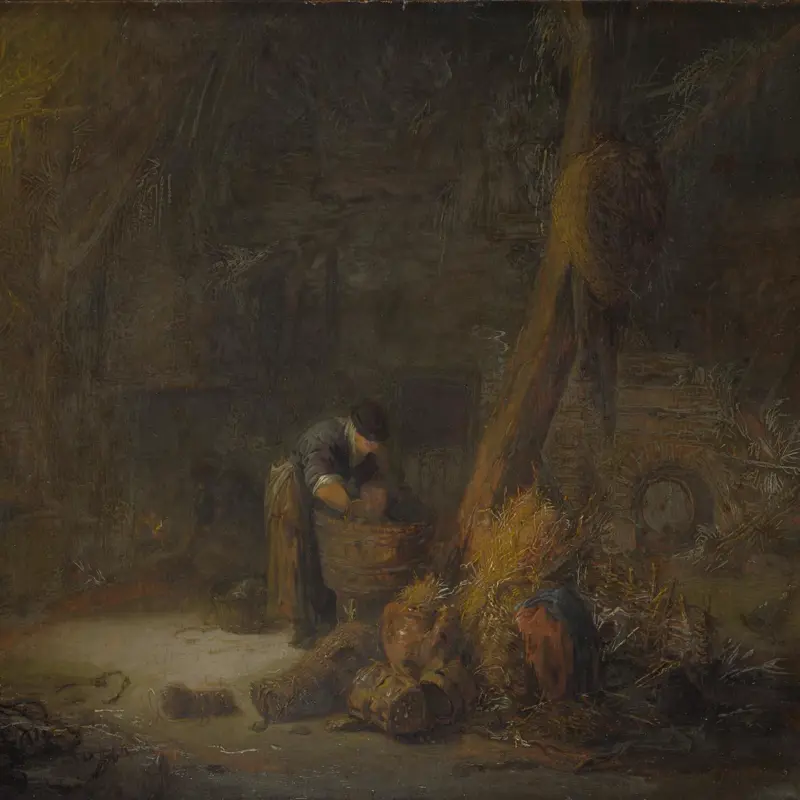Isack van Ostade, 'The Outskirts of a Village, with a Horseman', 1640s
About the work
Overview
Life seems to amble along in this painting: there’s time for the horseman to pause, for the man beside him to communicate with his dogs and for two people to chat. The countryside setting appears almost timeless, though Isack van Ostade has explored the effects of time. Light flickers up the wall of the old, crumbling house, revealing the rich browns and ochre of the brick, the wood and the rusting metal. Smoke comes from the chimney although the house seems otherwise deserted, its thatch thinning and weeds growing from the roof.
The painting is typical of van Ostade’s country scenes, with detail to be explored, skilfully depicted objects, and subtle colours and textures giving realism and mood. Although prolific, he died young and his painting career only lasted a decade, so his considerable promise was never fulfilled.
Key facts
Details
- Full title
- The Outskirts of a Village, with a Horseman
- Artist
- Isack van Ostade
- Artist dates
- 1621 - 1649
- Date made
- 1640s
- Medium and support
- oil on wood
- Dimensions
- 56.8 × 49.7 cm
- Acquisition credit
- Bought, 1871
- Inventory number
- NG847
- Location
- Room 23
- Collection
- Main Collection
- Previous owners
- Frame
- 17th-century Dutch Frame
Provenance
Additional information
Text extracted from the ‘Provenance’ section of the catalogue entry in Neil MacLaren, revised and expanded by Christopher Brown, ‘National Gallery Catalogues: The Dutch School: 1600–1900’, London 1991; for further information, see the full catalogue entry.
Exhibition history
-
2008Haarlem: the cradle of the Golden AgeFrans Hals Museum11 October 2008 - 1 February 2009Kunsthalle der Hypo-Kulturstiftung (Munich)13 February 2009 - 7 June 2009
Bibliography
-
1771P.F. Basan, Recueil d'estampes gravées d'après les tableaux du Cabinet de Monseigneur le duc de Choiseul par les soins du Sr Basan, Paris 1771
-
1829
J. Smith, A Catalogue Raisonné of the Works of the Most Eminent Dutch, Flemish, and French Painters: In Which is Included a Short Biographical Notice of the Artists, with a Copious Description of Their Principal Pictures […], 9 vols, London 1829-1842
-
1844A.M. Jameson, Companion to the Most Celebrated Private Galleries of Art in London: Containing Accurate Catalogues, Arranged Alphabetically, for Immediate Reference, Each Preceded by an Historical & Critical Introduction […], London 1844
-
1907C. Hofstede de Groot, Catalogue Raisonné of the Works of the Most Eminent Dutch Painters of the Seventeenth Century, 10 vols, London 1907
-
1907C. Hofstede de Groot, Catalogue Raisonné of the Works of the Most Eminent Dutch Painters of the Seventeenth Century, 10 vols, London 1907
-
1960Maclaren, Neil, National Gallery Catalogues: The Dutch School, 2 vols, London 1960
-
1991Maclaren, Neil, revised by Christopher Brown, National Gallery Catalogues: The Dutch School, 1600-1900, 2nd edn (revised and expanded), 2 vols, London 1991
-
2001
C. Baker and T. Henry, The National Gallery: Complete Illustrated Catalogue, London 2001
-
2008P. Biesboer et al., De Gouden Eeuw begint in Haarlem (exh. cat. Frans Hals Museum, 11 October 2008 - 1 February 2009; Kunsthalle der Hypo-Kulturstiftung, 13 February - 7 June 2009), Haarlem 2008
About this record
If you know more about this work or have spotted an error, please contact us. Please note that exhibition histories are listed from 2009 onwards. Bibliographies may not be complete; more comprehensive information is available in the National Gallery Library.





